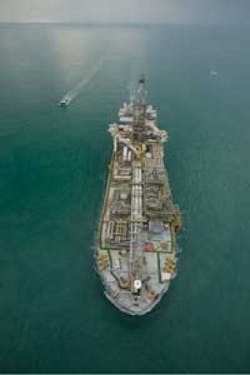VESSELS, RIGS, & SURFACE SYSTEMS
David Paganie • Houston
Caesar in transit
Helix Energy Solutions Group expects its new deepwater pipelay vesselCaesar to join the company’s subsea construction fleet in January. The vessel left a Chinese shipyard on Nov. 28, 2009, for transit to the Gulf of Mexico.
Caesar is a DP-2 vessel capable of laying large diameter concrete coated pipelines in shallow water, and up to 24-in. (61-cm) diameter pipelines in deepwater. The vessel’s onboard pipeline manufacturing capability allows for pipelay operations without dedicated onshore infrastructure, an alternative to reeled pipelay vessels in remote areas, according to Helix. The vessel also features a 300-metric ton (331-ton) crane and 450-metric ton (496-ton) A-frame.
Helix also expects delivery of its floating production unitHelix Producer I soon for deployment on the Phoenix field in the GoM in 2Q 2010. Recently the vessel was at Kiewit Offshore Services’ fabrication yard on the Gulf Coast for topsides outfitting and USCG inspections.
In other vessel news, Saipem has contracted Keppel Verolme to repair and modify the semisubmersible pipelay vesselCastoro Sei. Under the contract, Keppel will overhaul four thrusters, install new stinger handling support rails, and repair and modify the vessel’s onboard gantry cranes and fendering system. The company also will complete a hull blasting and painting program.
Work on the vessel is scheduled for completion in 1Q 2010. The vessel then will be deployed for the Nord Stream project, a gas pipeline that will link Russia and the European Union via the Baltic Sea.
String of FPSO contacts awarded
Petrobras Netherlands has awarded Keppel Offshore & Marine a contract for the pre-conversion of the FPSOP-58 for the Campos basin. Keppel Shipyard’s scope of work includes structural and piping renewal, tank coating as well as accommodation refurbishment and upgrading. In 1Q 2011, the vessel will sail to Brazil for the rest of the conversion, which includes topside completion work. P-58 will have production capacity for 180,000 b/d of oil and gas compression capacity for 6 MMcm/d (211.8 MMcf/d). It will operate in Parque das Baleias’ north field in the Campos basin and will be spread moored in 1,400 m (4,593 ft) of water.
Keppel Shipyard also picked up a contract from Emas Offshore Construction and Production, for the conversion of a Suezmax tanker into an FPSO. Upon completion in 1Q 2011, the FPSO will have capacity to produce up to 50,000 b/d of oil and store about 680,000 bbl of oil. The converted FPSO unit will be leased to Premier Oil Vietnam Offshore for the development of the Chim Sao field, offshore southeastern Vietnam.
Eni has awarded Saipem a $1.5-billion contract for the supply and operation of an FPSO. Under the 20-year contract, Saipem will provide FPSO installation and operation management. The vessel will have storage capacity for 700,000 b/d of oil and production capacity for 12,000 b/d of oil. London Marine Consultants designed the external turret mooring system which is being built at Dubai Dry Docks.
For the first eight years of the contract, the FPSO will be installed on the Aquila field in the Adriatic Sea. It will be connected to six risers and three umbilicals. First production is expected in 4Q 2011. During the remaining years of the contract, the FPSO will relocate to another client-designated field.
Hoang Long Joint Operating Co. has contracted Bumi Armada Berhad and Vietsovpetro to deliver an FPSO for the Te Giac Trang field development, offshore Vietnam. Bumi Armada has acquired a Suezmax tanker for the conversion. The contract is for an initial term of seven years and has one-year extensions up to 15 years. It also covers offshore installation, hookup, and commissioning of the FPSO. It will be fitted with production capacity for 45,000 b/d of oil and 1 MMbbl of oil storage.
Noble upgrading rigs for Petrobras
Noble has awarded Keppel FELS Brasil contracts totaling $304 million to upgrade and repair the drillshipsNoble Leo Segerius and Noble Roger Eason. Once completed, the rigs will be deployed for Petrobras offshore Brazil.
The contracts cover the fabrication, repair, and replacement of components, including the stern section, accommodation blocks, sponsons, and heliport. The first rig is scheduled to arrive at Keppel’s BrasFELS yard in Angra dos Reis, Brazil, in early 2011. Deliveries are scheduled between 4Q 2011 and the first half of 2012, respectively.
Keppel FELS also secured a letter of intent from PV Drilling to deliver a tender assist rig built to KFELS SSDT 3600E design. Targeted for delivery in 4Q 2011, the rig will have capacity to operate and maintain station keeping alongside spars and TLPs in water depths up to 5,000 ft (1,524 m). It will feature an eight-point mooring system to allow it to maintain position in currents up to six knots.
Noordhoek launches survey support vessel
Noordhoek Offshore has launched the ROV and survey support vesselNoordhoek Patherfinder from the De Hoop Shipyard in the Netherlands. The company is installing and commissioning the vessel’s crane and survey spread prior to beginning sea trials. The vessel is expected to be fully commissioned and ready for deployment in 1Q 2010.
TheNoordhoek Patherfinder features a DP-2 positioning system, diesel electric drive, a large moon pool, and an offshore crane. It is also equipped with work and inspection class ROV systems, side scan sonar tow-fish, McCartney Focus 2 ROTV systems, and a survey suite.
Transocean’s newbuild semisubmersible drilling rigDevelopment Driller III has started a seven-year contract with BP in the US Gulf of Mexico. The DP rig features a motion-compensated winch capable of deploying subsea assemblies to the seabed, a high-pressure mud-pump system, a variable deckload of 7,000 metric tons (7,716 tons), and Transocean’s patented dual-activity drilling technology. The rig is equipped to drill in water depths to 7,500 ft (2,286 m), upgradeable to 10,000 ft (3,048 m), and to drill wells to 35,000 ft (10,668 m) TD, upgradeable to 37,500 ft (11,430 m). Photo courtesy of Transocean.


